转载自http://blog.csdn.net/wizen641372472/article/details/72675549
Tensorflow Ubuntu16.04上安装及CPU运行tensorboard、CNN、RNN图文教程
Ubuntu16.04系统安装
- Win7 U盘安装Ubuntu16.04 双系统详细教程参看博客:http://blog.csdn.net/coderjyf/article/details/51241919
- VMware12安装虚拟机教程、Ubuntu16.04安装教程参看百度经验:http://jingyan.baidu.com/article/c275f6ba07e269e33d756714.html
- 懒人版:下载备份好的已装有Tensorflow的系统:http://pan.baidu.com/s/1eRPWlKu 密码:j3i2
- 懒人版系统还原方法:
①安装VMware Workstation,把下载好的懒人版系统Tensorflow_Ubuntu16.04.rar解压,用VMware Workstation打开,如图:

②开机密码:111111
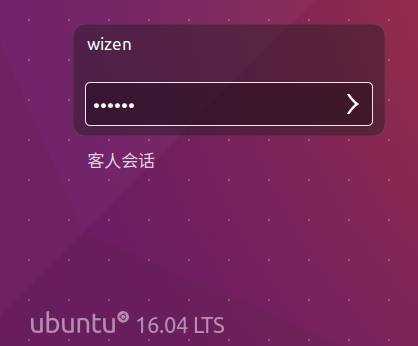
- 建议使用双系统的Ubuntu,因为虚拟机有点卡,如果你用的是懒人版的备份系统,你可以直接跳到tensorflow测试运行步骤了。
python3.5安装
1.ubuntu16.04系统会自带python2.7,请不要卸载它。不同版本的Python可以共存在一个系统上。Ctrl+Alt+T打开终端输入命令:python
可查看当前版本(exit()退出python编辑)。若卸载之后,桌面系统会被影响。
2.依次输入命令并回车(如有密码验证,输入密码,回车):
- $ sudo add-apt-repository ppa:fkrull/deadsnakes
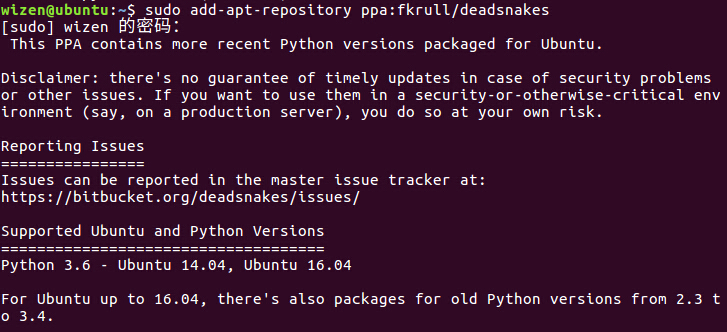
- $ sudo apt-get update

- $ sudo apt-get install python3.5
- $ sudo cp /usr/bin/python /usr/bin/python_bak,先备份
- $ sudo rm /usr/bin/python,删除
- $ sudo ln -s /usr/bin/python3.5 /usr/bin/python,默认设置成python3.5,重建软链接这样在终端中输入python默认就是 3.5版本了

Tensorflow安装
1.安装python3-pip
$ sudo apt-get install python3-pip
输入后会出现一串代码,然后问是否继续,输入y回车。
2.安装tensorflow
$ sudo pip3 install tensorflow
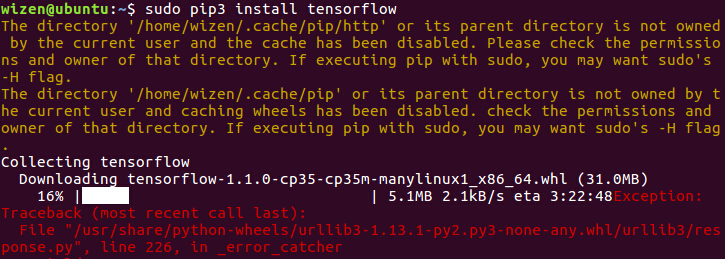
(1)若出现红色可选择重复此步操作或下载安装:

- 网盘下载: 链接:http://pan.baidu.com/s/1eSOQ5zG 密码:aqkr
(2)把下载好的文件放到home目录下,可通过ls查看到

①执行安装tensorflow,若出现红色可选择重复此步操作。
$ sudo pip3 install tensorflow-1.2.0rc0-cp35-cp35m-manylinux1_x86_64.whl
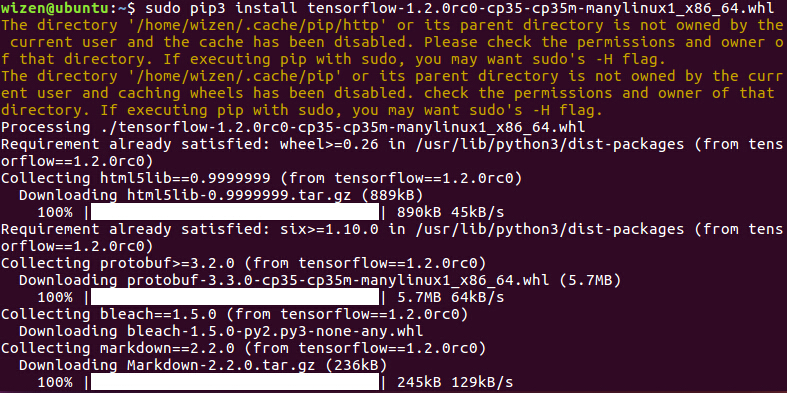
②安装成功界面如下:

1.下载
- 网盘下载: http://pan.baidu.com/s/1i4HIAhf密码:e7js
2.把下载好的文件放到home目录下,解压该文件(在文件上右击执行“提取到此处”),可通过ls查看到

①打开Komodo-Edit-10.2.1-17670-linux-x86_64文件夹
$ cd Komodo-Edit-10.2.1-17670-linux-x86_64/

②输入 sudo ./install.sh 安装Komodo-Edit,安装完成后,搜索“Komodo”即可打开该软件

Tensorflow测试运行
1.tensorboard.py
- """
- Please note, this code is only for python 3+. If you are using python 2+, please modify the code accordingly.
- """
- from __future__ import print_function
- import tensorflow as tf
- import numpy as np
- def add_layer(inputs, in_size, out_size, n_layer, activation_function=None):
- # add one more layer and return the output of this layer
- layer_name = 'layer%s' % n_layer
- with tf.name_scope(layer_name):
- with tf.name_scope('weights'):
- Weights = tf.Variable(tf.random_normal([in_size, out_size]), name='W')
- tf.summary.histogram(layer_name + '/weights', Weights)
- with tf.name_scope('biases'):
- biases = tf.Variable(tf.zeros([1, out_size]) + 0.1, name='b')
- tf.summary.histogram(layer_name + '/biases', biases)
- with tf.name_scope('Wx_plus_b'):
- Wx_plus_b = tf.add(tf.matmul(inputs, Weights), biases)
- if activation_function is None:
- outputs = Wx_plus_b
- else:
- outputs = activation_function(Wx_plus_b, )
- tf.summary.histogram(layer_name + '/outputs', outputs)
- return outputs
- # Make up some real data
- x_data = np.linspace(-1, 1, 300)[:, np.newaxis]
- noise = np.random.normal(0, 0.05, x_data.shape)
- y_data = np.square(x_data) - 0.5 + noise
- # define placeholder for inputs to network
- with tf.name_scope('inputs'):
- xs = tf.placeholder(tf.float32, [None, 1], name='x_input')
- ys = tf.placeholder(tf.float32, [None, 1], name='y_input')
- # add hidden layer
- l1 = add_layer(xs, 1, 10, n_layer=1, activation_function=tf.nn.relu)
- # add output layer
- prediction = add_layer(l1, 10, 1, n_layer=2, activation_function=None)
- # the error between prediciton and real data
- with tf.name_scope('loss'):
- loss = tf.reduce_mean(tf.reduce_sum(tf.square(ys - prediction),
- reduction_indices=[1]))
- tf.summary.scalar('loss', loss)
- with tf.name_scope('train'):
- train_step = tf.train.GradientDescentOptimizer(0.1).minimize(loss)
- sess = tf.Session()
- merged = tf.summary.merge_all()
- writer = tf.summary.FileWriter("logs/", sess.graph)
- init = tf.global_variables_initializer()
- sess.run(init)
- for i in range(1000):
- sess.run(train_step, feed_dict={xs: x_data, ys: y_data})
- if i % 50 == 0:
- result = sess.run(merged,
- feed_dict={xs: x_data, ys: y_data})
- writer.add_summary(result, i)
- # direct to the local dir and run this in terminal:
- # $ tensorboard --logdir logs
①在home目录建立tensorflower文件夹,把tensorboard.py放入该目录下,运行如下命令:
$ cd tensorflow/
$ python
tensorboard.py
②此时tensorflow文件夹下将产生一个logs文件夹,然后输入命令能产生查看tensorboard的网址:
$ tensorboard --logdir logs
运行如下图所示:
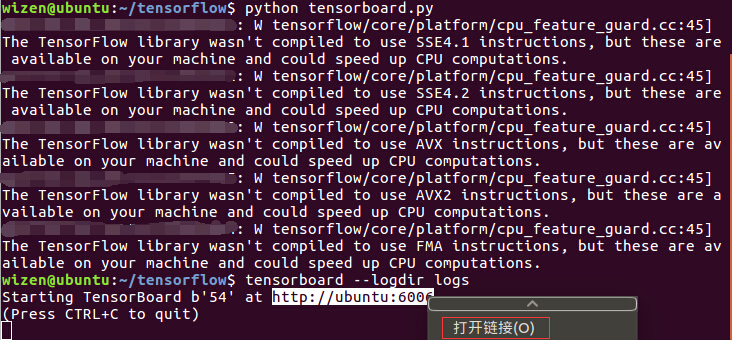
③打开
http://ubuntu:6006即可查看,loss曲线:
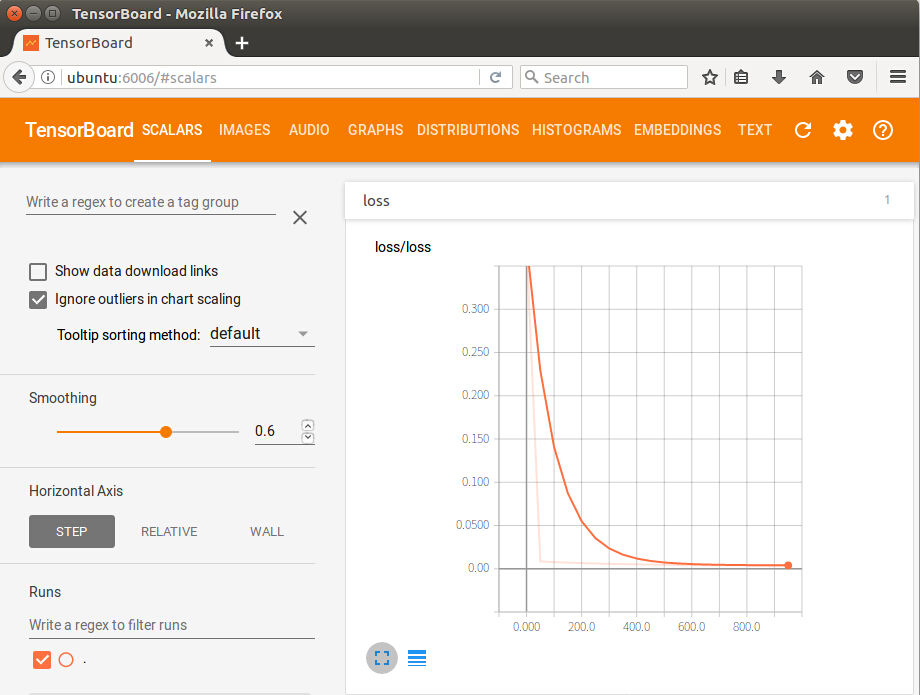
④神经网络图:
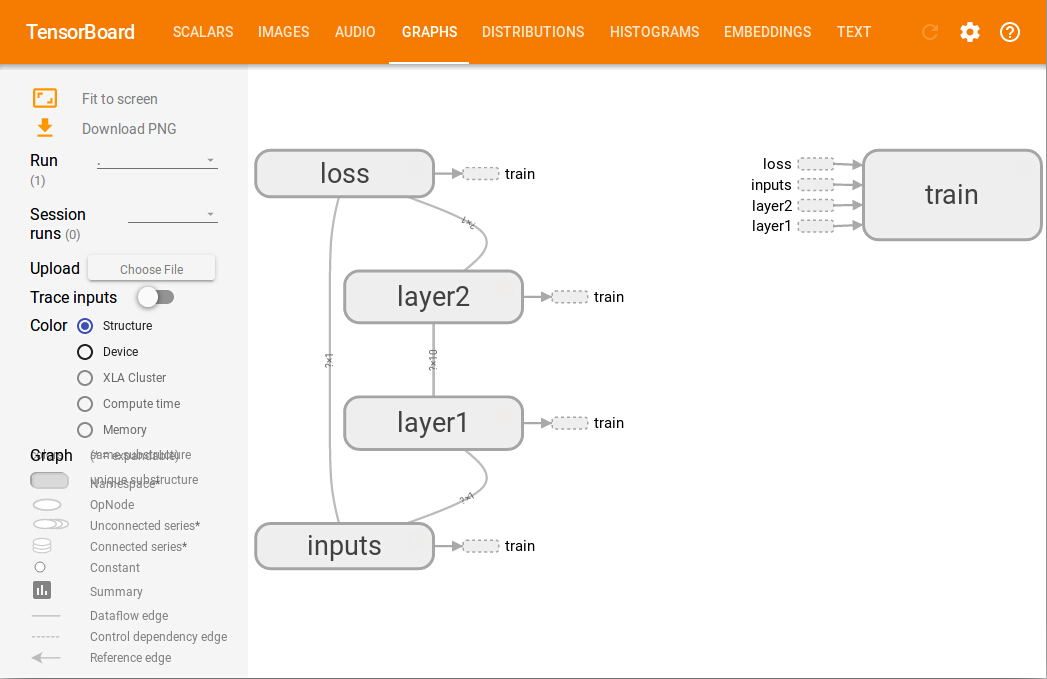 ;
;
⑤每一层的weights和biases变化情况
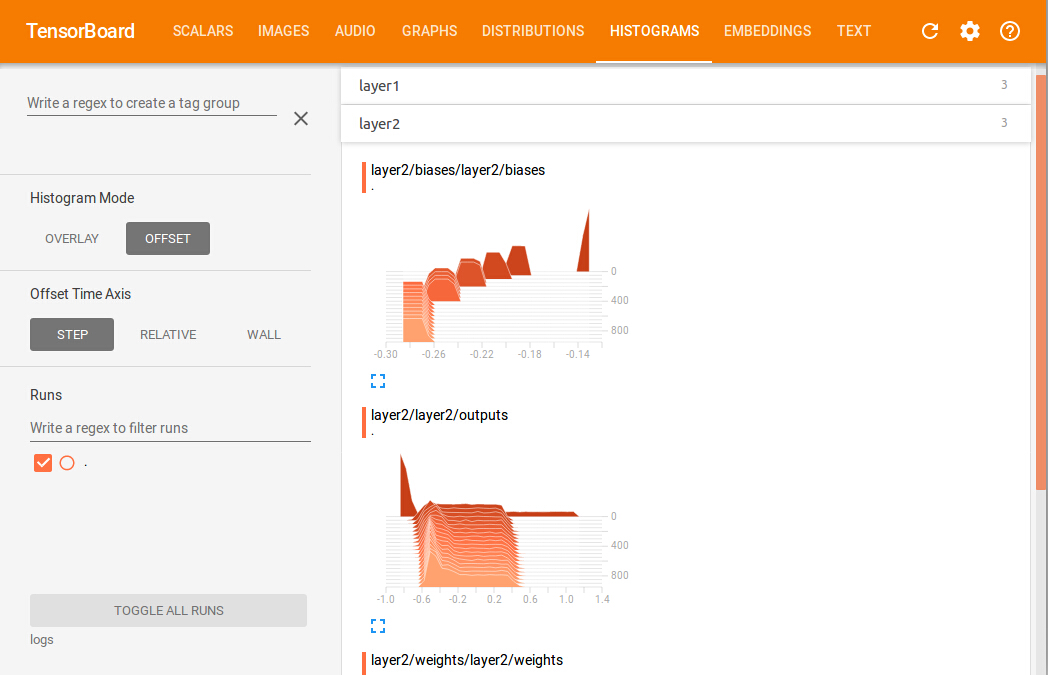
2.CNN.py
- """
- Please note, this code is only for python 3+. If you are using python 2+, please modify the code accordingly.
- """
- from __future__ import print_function
- import tensorflow as tf
- from tensorflow.examples.tutorials.mnist import input_data
- # number 1 to 10 data
- mnist = input_data.read_data_sets('MNIST_data', one_hot=True)
- def compute_accuracy(v_xs, v_ys):
- global prediction
- y_pre = sess.run(prediction, feed_dict={xs: v_xs, keep_prob: 1})
- correct_prediction = tf.equal(tf.argmax(y_pre,1), tf.argmax(v_ys,1))
- accuracy = tf.reduce_mean(tf.cast(correct_prediction, tf.float32))
- result = sess.run(accuracy, feed_dict={xs: v_xs, ys: v_ys, keep_prob: 1})
- return result
- def weight_variable(shape):
- initial = tf.truncated_normal(shape, stddev=0.1)
- return tf.Variable(initial)
- def bias_variable(shape):
- initial = tf.constant(0.1, shape=shape)
- return tf.Variable(initial)
- def conv2d(x, W):
- # stride [1, x_movement, y_movement, 1]
- # Must have strides[0] = strides[3] = 1
- return tf.nn.conv2d(x, W, strides=[1, 1, 1, 1], padding='SAME')
- def max_pool_2x2(x):
- # stride [1, x_movement, y_movement, 1]
- return tf.nn.max_pool(x, ksize=[1,2,2,1], strides=[1,2,2,1], padding='SAME')
- # define placeholder for inputs to network
- xs = tf.placeholder(tf.float32, [None, 784])/255. # 28x28
- ys = tf.placeholder(tf.float32, [None, 10])
- keep_prob = tf.placeholder(tf.float32)
- x_image = tf.reshape(xs, [-1, 28, 28, 1])
- # print(x_image.shape) # [n_samples, 28,28,1]
- ## conv1 layer ##
- W_conv1 = weight_variable([5,5, 1,32]) # patch 5x5, in size 1, out size 32
- b_conv1 = bias_variable([32])
- h_conv1 = tf.nn.relu(conv2d(x_image, W_conv1) + b_conv1) # output size 28x28x32
- h_pool1 = max_pool_2x2(h_conv1) # output size 14x14x32
- ## conv2 layer ##
- W_conv2 = weight_variable([5,5, 32, 64]) # patch 5x5, in size 32, out size 64
- b_conv2 = bias_variable([64])
- h_conv2 = tf.nn.relu(conv2d(h_pool1, W_conv2) + b_conv2) # output size 14x14x64
- h_pool2 = max_pool_2x2(h_conv2) # output size 7x7x64
- ## fc1 layer ##
- W_fc1 = weight_variable([7*7*64, 1024])
- b_fc1 = bias_variable([1024])
- # [n_samples, 7, 7, 64] ->> [n_samples, 7*7*64]
- h_pool2_flat = tf.reshape(h_pool2, [-1, 7*7*64])
- h_fc1 = tf.nn.relu(tf.matmul(h_pool2_flat, W_fc1) + b_fc1)
- h_fc1_drop = tf.nn.dropout(h_fc1, keep_prob)
- ## fc2 layer ##
- W_fc2 = weight_variable([1024, 10])
- b_fc2 = bias_variable([10])
- prediction = tf.nn.softmax(tf.matmul(h_fc1_drop, W_fc2) + b_fc2)
- # the error between prediction and real data
- cross_entropy = tf.reduce_mean(-tf.reduce_sum(ys * tf.log(prediction),
- reduction_indices=[1])) # loss
- train_step = tf.train.AdamOptimizer(1e-4).minimize(cross_entropy)
- sess = tf.Session()
- # important step
- # tf.initialize_all_variables() no long valid from
- # 2017-03-02 if using tensorflow >= 0.12
- if int((tf.__version__).split('.')[1]) < 12 and int((tf.__version__).split('.')[0]) < 1:
- init = tf.initialize_all_variables()
- else:
- init = tf.global_variables_initializer()
- sess.run(init)
- for i in range(1000):
- batch_xs, batch_ys = mnist.train.next_batch(100)
- sess.run(train_step, feed_dict={xs: batch_xs, ys: batch_ys, keep_prob: 0.5})
- if i % 50 == 0:
- print(compute_accuracy(
- mnist.test.images, mnist.test.labels))
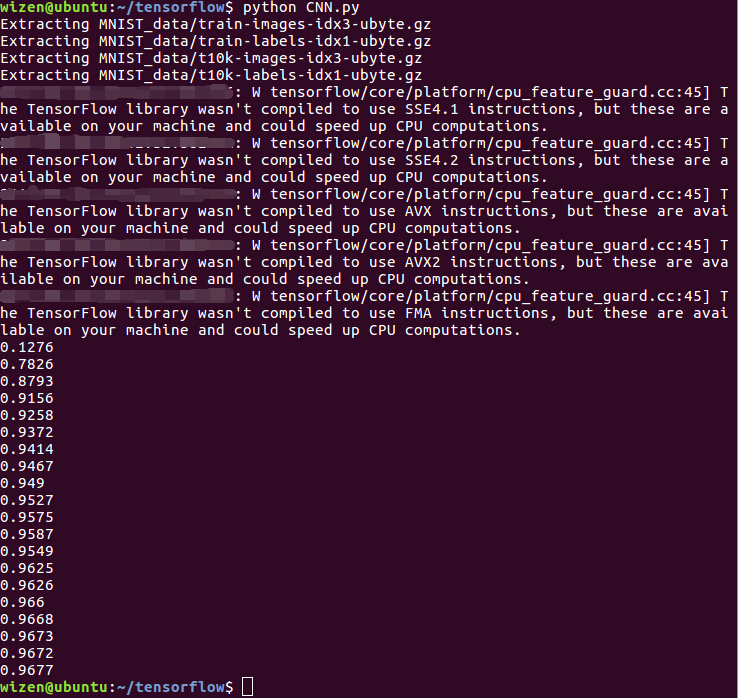
3.RNN.py
- """
- This code is a modified version of the code from this link:
- https://github.com/aymericdamien/TensorFlow-Examples/blob/master/examples/3_NeuralNetworks/recurrent_network.py
- His code is a very good one for RNN beginners. Feel free to check it out.
- """
- import tensorflow as tf
- from tensorflow.examples.tutorials.mnist import input_data
- # set random seed for comparing the two result calculations
- tf.set_random_seed(1)
- # this is data
- mnist = input_data.read_data_sets('MNIST_data', one_hot=True)
- # hyperparameters
- lr = 0.001 #learning rate
- training_iters = 100000
- batch_size = 128
- n_inputs = 28 # MNIST data input (img shape: 28*28)
- n_steps = 28 # time steps
- n_hidden_units = 128 # neurons in hidden layer
- n_classes = 10 # MNIST classes (0-9 digits)
- # tf Graph input
- x = tf.placeholder(tf.float32, [None, n_steps, n_inputs])
- y = tf.placeholder(tf.float32, [None, n_classes])
- # Define weights
- weights = {
- # (28, 128)
- 'in': tf.Variable(tf.random_normal([n_inputs, n_hidden_units])),
- # (128, 10)
- 'out': tf.Variable(tf.random_normal([n_hidden_units, n_classes]))
- }
- biases = {
- # (128, )
- 'in': tf.Variable(tf.constant(0.1, shape=[n_hidden_units, ])),
- # (10, )
- 'out': tf.Variable(tf.constant(0.1, shape=[n_classes, ]))
- }
- def RNN(X, weights, biases):
- # hidden layer for input to cell
- ########################################
- # transpose the inputs shape from
- # X ==> (128 batch * 28 steps, 28 inputs)
- X = tf.reshape(X, [-1, n_inputs])
- # into hidden
- # X_in = (128 batch * 28 steps, 128 hidden)
- X_in = tf.matmul(X, weights['in']) + biases['in']
- # X_in ==> (128 batch, 28 steps, 128 hidden)
- X_in = tf.reshape(X_in, [-1, n_steps, n_hidden_units])
- # cell
- ##########################################
- # basic LSTM Cell.
- if int((tf.__version__).split('.')[1]) < 12 and int((tf.__version__).split('.')[0]) < 1:
- cell = tf.nn.rnn_cell.BasicLSTMCell(n_hidden_units, forget_bias=1.0, state_is_tuple=True)
- else:
- cell = tf.contrib.rnn.BasicLSTMCell(n_hidden_units)
- # lstm cell is divided into two parts (c_state, h_state)
- init_state = cell.zero_state(batch_size, dtype=tf.float32)
- # You have 2 options for following step.
- # 1: tf.nn.rnn(cell, inputs);
- # 2: tf.nn.dynamic_rnn(cell, inputs).
- # If use option 1, you have to modified the shape of X_in, go and check out this:
- # https://github.com/aymericdamien/TensorFlow-Examples/blob/master/examples/3_NeuralNetworks/recurrent_network.py
- # In here, we go for option 2.
- # dynamic_rnn receive Tensor (batch, steps, inputs) or (steps, batch, inputs) as X_in.
- # Make sure the time_major is changed accordingly.
- outputs, final_state = tf.nn.dynamic_rnn(cell, X_in, initial_state=init_state, time_major=False)
- # hidden layer for output as the final results
- #############################################
- # results = tf.matmul(final_state[1], weights['out']) + biases['out']
- # # or
- # unpack to list [(batch, outputs)..] * steps
- if int((tf.__version__).split('.')[1]) < 12 and int((tf.__version__).split('.')[0]) < 1:
- outputs = tf.unpack(tf.transpose(outputs, [1, 0, 2])) # states is the last outputs
- else:
- outputs = tf.unstack(tf.transpose(outputs, [1,0,2]))
- results = tf.matmul(outputs[-1], weights['out']) + biases['out'] # shape = (128, 10)
- return results
- pred = RNN(x, weights, biases)
- cost = tf.reduce_mean(tf.nn.softmax_cross_entropy_with_logits(logits=pred, labels=y))
- train_op = tf.train.AdamOptimizer(lr).minimize(cost)
- correct_pred = tf.equal(tf.argmax(pred, 1), tf.argmax(y, 1))
- accuracy = tf.reduce_mean(tf.cast(correct_pred, tf.float32))
- with tf.Session() as sess:
- # tf.initialize_all_variables() no long valid from
- # 2017-03-02 if using tensorflow >= 0.12
- if int((tf.__version__).split('.')[1]) < 12 and int((tf.__version__).split('.')[0]) < 1:
- init = tf.initialize_all_variables()
- else:
- init = tf.global_variables_initializer()
- sess.run(init)
- step = 0
- while step * batch_size < training_iters:
- batch_xs, batch_ys = mnist.train.next_batch(batch_size)
- batch_xs = batch_xs.reshape([batch_size, n_steps, n_inputs])
- sess.run([train_op], feed_dict={
- x: batch_xs,
- y: batch_ys,
- })
- if step % 20 == 0:
- print(sess.run(accuracy, feed_dict={
- x: batch_xs,
- y: batch_ys,
- }))
- step += 1
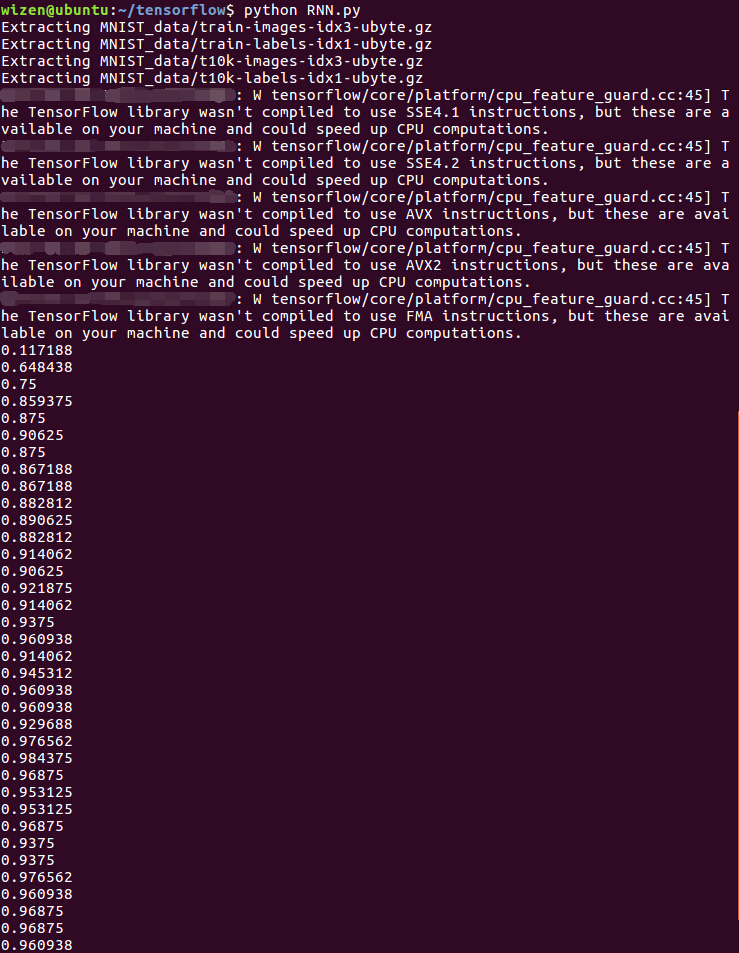
ps:如想详细了解以上代码的具体讲解可参看:
https://morvanzhou.github.io/tutorials/machine-learning/tensorflow/
或者网盘下载视频:链接:
http://pan.baidu.com/s/1i57P1hN 密码:rxgh,以上代码均在该视频学习指导下完成。









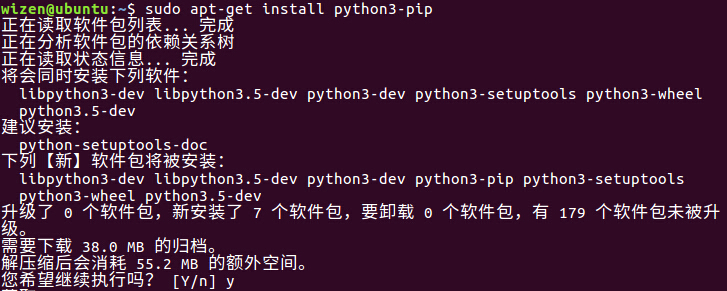














 2358
2358

 被折叠的 条评论
为什么被折叠?
被折叠的 条评论
为什么被折叠?








